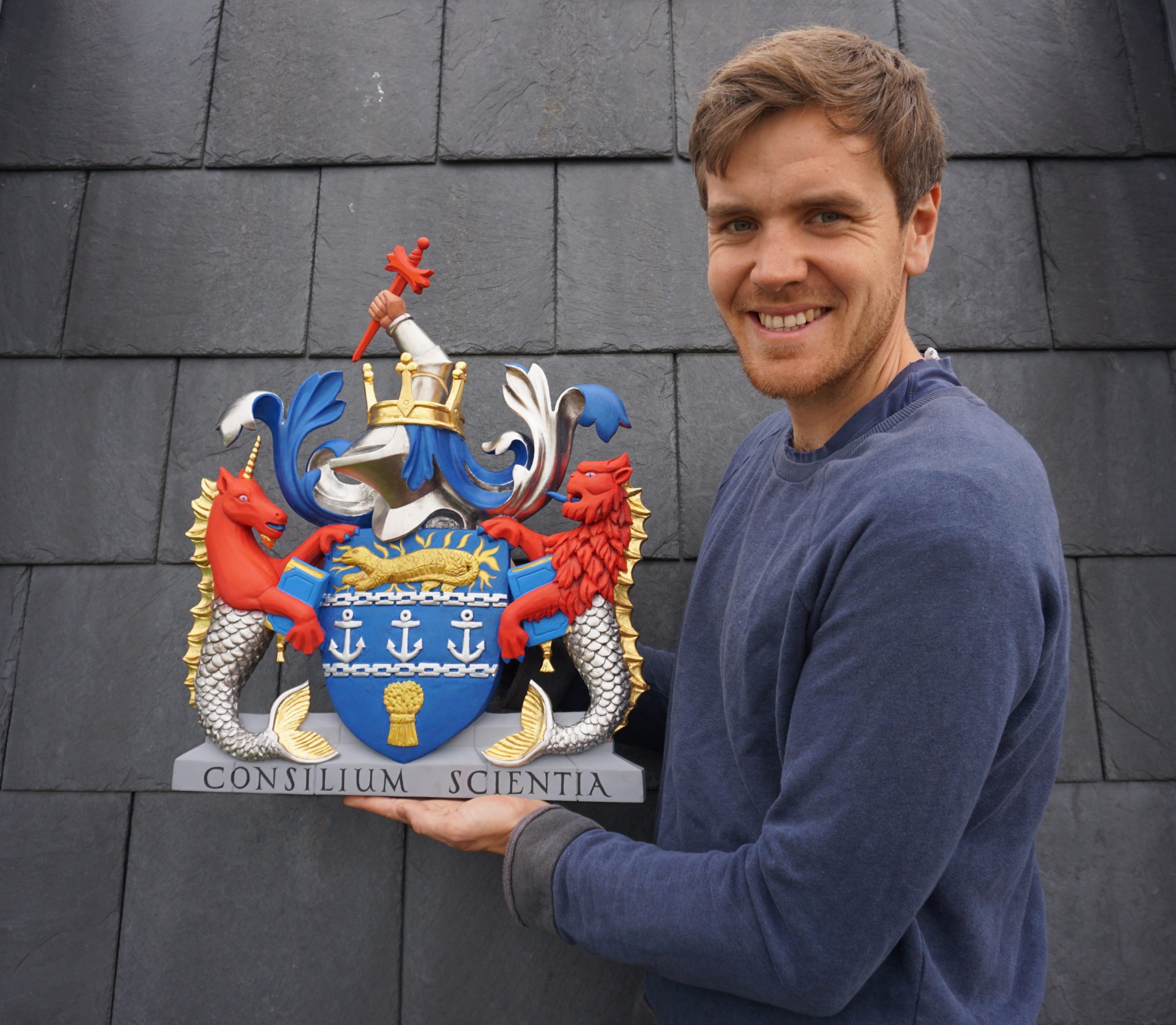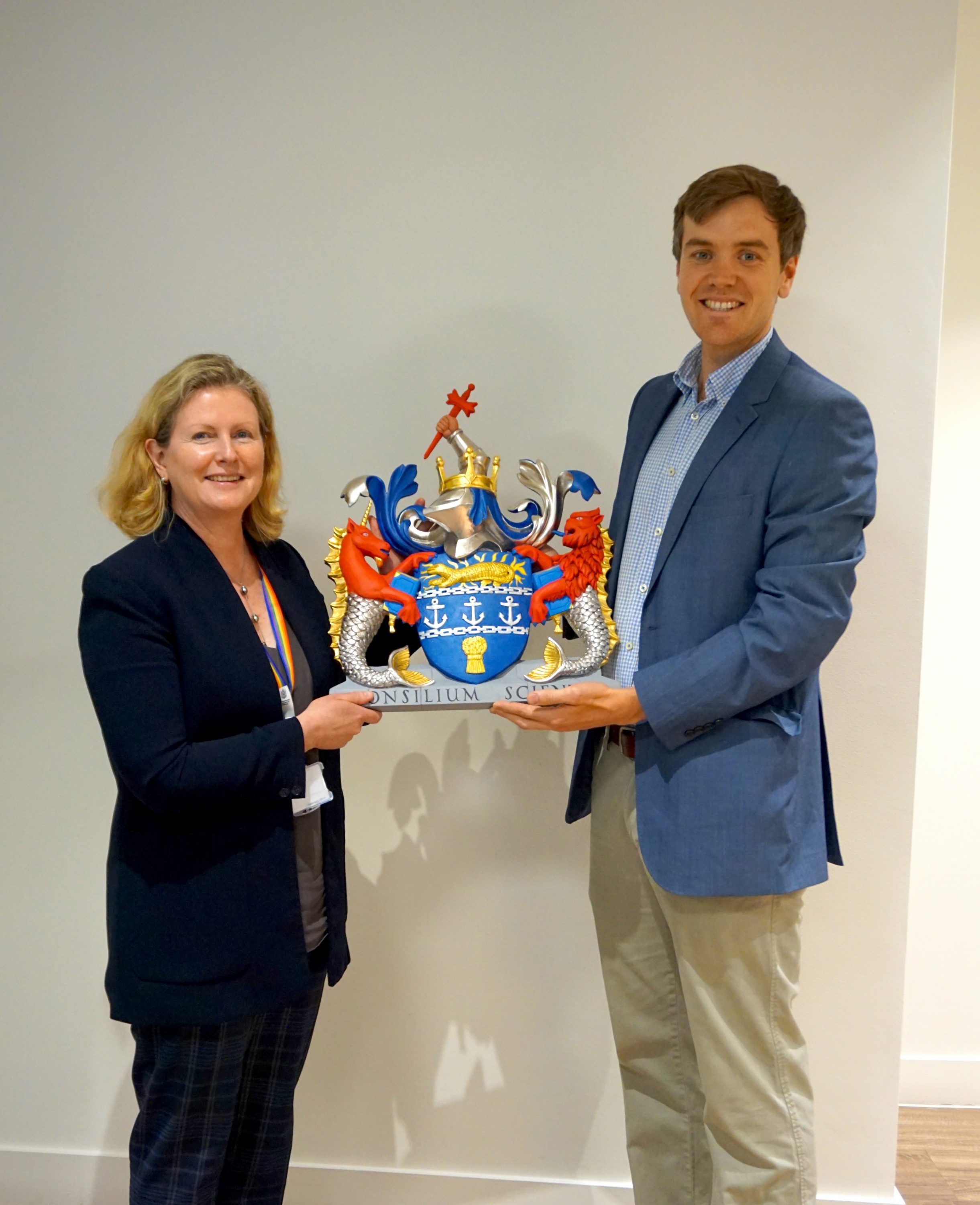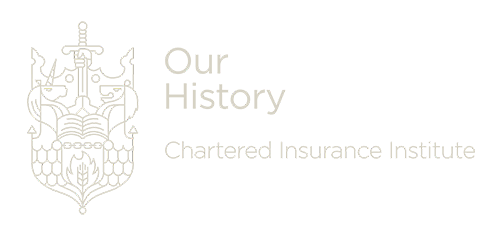Alongside the historic artefacts on display at the Chartered Insurance Institute’s Lombard Street offices, there is now a new object set to capture the attention of members. The entrance hall of the Lombard Street office now features a new wooden carving of the body’s historic Coat of Arms.

William Barsley holding the coat of arms
The Coat of Arms was produced by William Barsley, who five years ago retrained with the City and Guilds of London Art School so he could turn his back on his office desk job at the United Nations in Rome to become a professional woodcarver. Mr Barsley, said the carving of the CII’s Coat of Arms took him roughly one month to produce.
About 60 per cent of the time Mr Barsley spent producing the Coat of Arms was spent on carving Quebec pinewood with the other 40 per cent spent on painting and gilding the fish scales, helmet, crown and arm with a combination of gold, caplin and palladium metal leaf.

Water gilding process of the coat of arms
He gilded the Coat of Arms using the traditional method of water gilding, in which layers of gesso (made from rabbit skin glue and whiting) were built up before applying the metal leaf.
Mr Barsley said: “As with most of my work, this piece was bespoke and so I had never carved this particular design before. For me, this is what adds real excitement to the process.
“I therefore usually make a one-to-one model in clay before starting to carve the wood, to ensure any scale or design issues are fully resolved. On this particular piece, one fun challenge was jointing the sword onto the armoured hand and ensuring it lined up perfectly.”
Playful heraldry
When the CII rebranded in 2017, the CII’s Coat of Arms was updated to deliver a distinctive and contemporary illustration of the body’s rich heritage.
So, what does Mr Barsley hope visitors to the CII’s offices will take away from looking at his new carving of our historic Coat of Arms alongside the many insurance artefacts on display in Lombard Street?
He said: “My hope is that the Coat of Arms I have carved for the CII portrays the history and quality of the institution, as well as celebrating the playful side of heraldry through the heraldic beasts.”
Mr Barsley revealed the fact he has carved the Coat of Arms is also likely to be a source of pride to his family, as he believes his grandfather John Plumer achieved one of the quickest acceptances as a Lloyds Broker.
He said: “It was a great connection to have made the CII Coat of Arms. I am sure he (my grandfather) would have been happy.”
You can see more of Mr Barsley’s work by visiting: www.williambarsley.com and view the Coat of Arms by visiting the CII’s Lombard Street offices.

Sian Fisher CEO and William Barsley displaying the recently carved coats of arms
Coat of Arms elements and symbolic meaning:
Sword & hand
The hand grasping the blade of the sword of St Pauls, rather than the hilt, is symbolic of the weapon being neutralised. This is aligned to the fundamental purpose of insurance being to mitigate harm and hurt.
Supporters
The unicorn and lion (termed ‘supporters’) represent the national role that the Chartered Insurance Institute plays; the royal lion of England and the unicorn of Scotland. Both creatures are depicted with fish tails.
Book
The open book between supporters symbolises the Institute’s role as a professional body responsible for career guidance, education and the award of qualifications that demonstrate the principles that govern insurance and financial planning practice.
Fire, wheat & anchor
The Chartered Insurance Institute’s shield of arms illustrates the main original classes of insurance: fire (flame), life (wheatsheaf) and marine (anchor). The horizontal chain symbolises the fourth main class of accident insurance, and more generally the security provided by insurance.

